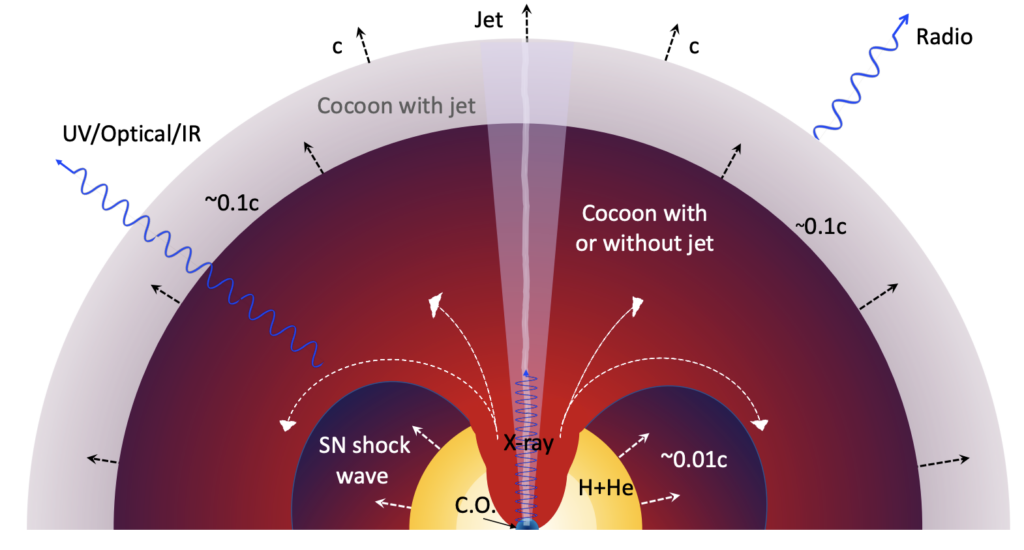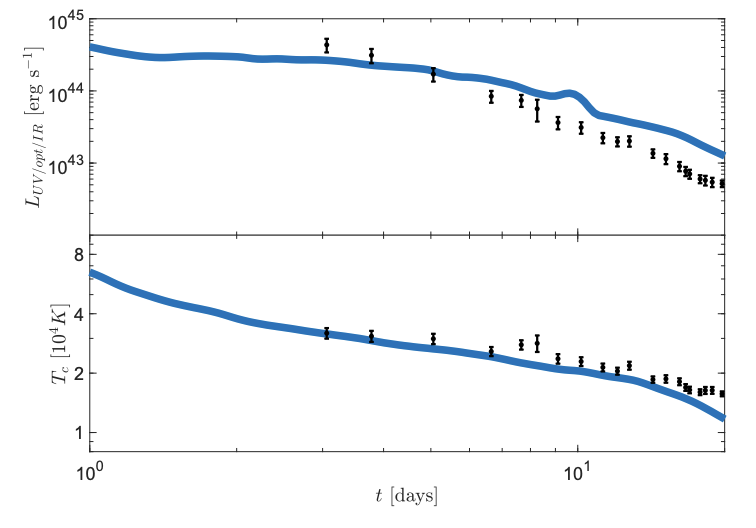Title: Shocked jets in CCSNe can power the zoo of fast blue optical transients
Authors: Ore Gottlieb, Alexander Tchekhovskoy, Raffaella Margutti
First Author’s Institution: Center for Interdisciplinary Exploration & Research in Astrophysics (CIERA), Physics & Astronomy, Northwestern University, Evanston, IL 60201, USA
Status: Open access on arXiv
Understanding FBOTs
Many images of objects in our own Galaxy and other galaxies within our universe may make it seem that the universe in which we live is a peaceful and quiet place. While this may be true in some cases, there are few places where it is less true than the site of an explosive transient where light and matter are strewn about. In recent years, due to the expansion of all-sky surveys, the discovery of such transients has increased rapidly.
Perhaps the most well-known of all transients are supernovae, the explosive deaths of stars. They exist in two main varieties: core-collapse supernovae (the deaths of massive stars) and thermonuclear supernovae (the deaths of white dwarfs). Recently however, a new class of transients known as fast blue optical transients (FBOTs) has emerged. As their name implies, they are rapidly-evolving transients with blue spectra in the optical wavelength band.
To date, 5 of these transients have been discovered, and they broadly share the following features: a fast rise in brightness, a high peak luminosity, a thermal optical spectrum, the presence of broad hydrogen emission lines, a power-law decay in luminosity, and a plateau in the temperature at late times. Additionally, the fact that many FBOTs live in star-forming galaxies suggests that their origin may be linked to the fates of massive stars.
A Transient Cocoon?
The authors of today’s paper propose a new model to describe the emission seen in FBOTs. They propose that dying massive stars that launch relativistic jets (material launched near the speed of light) may be able to explain the observed properties of FBOTs. Figure 1 illustrates a cartoon depiction of their model.
As a massive star collapses, several processes can send material flying outward including stellar material shocked by the supernova shock wave, extremely fast particles in a relativistic jet from the central compact object, or material shocked by the jet itself (called a cocoon). These processes naturally lead to a range of velocities for the outflow, from a few percent of the speed of light to relativistic speeds about 95% of the speed of light.
In this model, the ultraviolet (UV), optical, and near-infrared (NIR) emission at early times is created when the shocked cocoon cools. This can explain both the spectral features seen in FBOTs as well as the hot temperatures. At late times, the model predicts that the dominant driver of the UV/optical/NIR emission is from cooling of the supernova-shocked material rather than from cocoon cooling, leading to a transition in the radius, temperature, and luminosity of the FBOT. A feature like this may have been observed in AT2018cow, the best studied FBOT to date.

The authors also test their model predictions against the radio and X-ray characteristics of FBOTs. They find that, in their model, radio emission can be produced by synchrotron emission from the interaction of the cocoon and the surrounding circumstellar medium, which has been deposited by stellar winds. As the jet enters our line of sight, the radio emission peaks and then quickly declines. Additionally, the model predicts that X-ray emission from the newly-formed compact object diffuses out along the path of the jet on timescales of a few days. However, the model also predicts that, within the first few hours, X-rays produced by free-free radiation may also be observable.
Comparing to the Data
Now that the authors have a model that qualitatively describes the properties of FBOTs, it is time to test the model against real data. Figure 2 shows the model predictions in blue as compared to the data of AT2018cow in black. For both the luminosity and temperature, there is reasonable agreement between the model and the data, especially at early times.

Now that the authors have created a model that adequately describes many of the observed properties of FBOTs, what are the next steps in understanding the detailed physics of these objects? The authors suggest that early detections, within a day of explosion, are vital. Early detections of either X-ray or optical emission can provide hints towards the structure of the cocoon and towards the interplay of the surrounding material, the supernova outflow, and the jet itself. While FBOTs are somewhat rare (about 100 times less common than core-collapse supernovae), as we continue to find more of these explosive blue transients, we will continue to improve our understanding of this unique and intriguing source class.
Astrobite edited by Ryan Golant
Featured image credit: NASA
"can" - Google News
January 23, 2022 at 04:57PM
https://ift.tt/3ADTXZ7
Transient Butterflies: Fast Blue Optical Transients can be powered by Jet-Shocked Cocoons - Astrobites
"can" - Google News
https://ift.tt/2NE2i6G
https://ift.tt/3d3vX4n
Bagikan Berita Ini














0 Response to "Transient Butterflies: Fast Blue Optical Transients can be powered by Jet-Shocked Cocoons - Astrobites"
Post a Comment